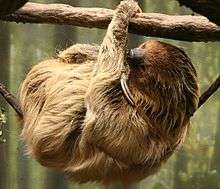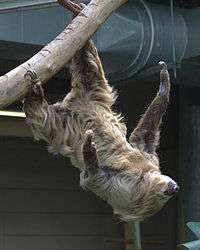Two-toed sloth
Choloepus is a genus of xenarthran mammals of Central and South America within the monotypic family Choloepodidae, consisting of two-toed sloths (also less misleadingly known as "two-fingered" sloths).[2][3] The two species of Choloepus (which means "lame foot"[4]), Linnaeus's two-toed sloth (Choloepus didactylus) and Hoffmann's two-toed sloth (Choloepus hoffmanni), were formerly believed on the basis of morphological studies to be the only surviving members of the sloth family Megalonychidae,[5] but have now been shown by molecular results to be closest to extinct ground sloths of the family Mylodontidae.[2][3]
| Two-toed sloths[1] | |
|---|---|
 | |
| Linnaeus's two-toed sloth (Choloepus didactylus) | |
| Scientific classification | |
| Kingdom: | Animalia |
| Phylum: | Chordata |
| Class: | Mammalia |
| Order: | Pilosa |
| Suborder: | Folivora |
| Family: | Choloepodidae Delsuc et al., 2019[2] |
| Genus: | Choloepus Illiger, 1811[1] |
| Species | |
Extant species
| Image | Scientific name | Common Name | Distribution |
|---|---|---|---|
 | Choloepus didactylus | Linnaeus's two-toed sloth | Northern South America, found in Venezuela, the Guyanas, Colombia, Ecuador, Peru, and Brazil north of the Amazon River |
_crop.jpg) | Choloepus hoffmanni | Hoffmann's two-toed sloth | Central America and northwestern South America |
Evolution
A study of retrovirus and mitochondrial DNA suggests that C. didactylus and C. hoffmani diverged 6 to 7 million years ago.[6] Furthermore, based on cytochrome c oxidase subunit I sequences, a similar divergence date (c. 7 million years ago) between the two populations of C. hofmanni separated by the Andes has been reported.[7]
Relation to the three-toed sloth
Both types of sloth tend to occupy the same forests; in most areas, a particular species of the somewhat smaller and generally slower-moving three-toed sloth (Bradypus) and a single species of the two-toed type will jointly predominate. Although similar in overall appearance, the relationship between the two genera is not close. Recent phylogenetic analyses[8] support analysis of morphological data from the 1970s and 1980s, indicating the two genera are not closely related and adapted to their arboreal lifestyles independently. It was unclear from this work from which, ground-dwelling sloth taxa the three-toed sloths evolved. Based on the morphological comparisons, it was thought the two-toed sloths nested phylogenetically within one of the divisions of Caribbean sloths.[9] Though data has been collected on over 33 different species of sloths by analyzing bone structures, many of the relationships between clades on a phylogenetic tree were unclear.[10]
Much of the morphological evidence to support the hypothesis of diphyly has been based on the structure of the inner ear.[11] Most morphological studies have concluded that convergent evolution is the mechanism that resulted in today’s two genera of tree sloths. This means that the extant genera evolved analogous traits, such as locomotion methods, size, habitat, and many other traits independently from one another as opposed to from their last common ancestor. This makes tree sloths “one of the most striking examples of convergent evolution known among mammals”.[10]
Recently obtained molecular data from collagen[3] and mitochodrial DNA[2] sequences fall in line with the diphyly (convergent evolution) hypothesis, but have overturned some of the other conclusions obtained from morphology. These investigations consistently place two-toed sloths close to mylodontids and three-toed sloths within Megatherioidea, close to Megalonyx, megatheriids and nothrotheriids. They make the previously recognized family Megalonychidae polyphyletic, with both two-toed sloths and the Caribbean sloths being moved away from Megalonyx. Caribbean sloths are placed in a separate, basal branch of the sloth evolutionary tree.[3][2]
The following sloth family phylogenetic tree is based on collagen and mitochondrial DNA sequence data (see Fig. 4 of Presslee et al., 2019).[3]
| Folivora |
| |||||||||||||||||||||||||||||||||||||||||||||||||||||
Characteristics

The name "two-toed sloth" was intended to describe an anatomical difference between the genera Choloepus and Bradypus, but does so in a potentially misleading way. Members of Choloepus have two digits on their forelimbs (the thoracic limbs) and three digits on their hindlimbs (the pelvic limbs), while members of Bradypus have three digits on all limbs. Although the term "two-fingered" sloth is arguably less misleading, the shorter "two-toed" is much more widely used.[note 1]
Members of Choloepus are larger than three-toed sloths, having a body length of 58 to 70 centimetres (23 to 28 in), and weighing 4 to 8 kilograms (8.8 to 17.6 lb). Other distinguishing features include a more prominent snout, longer fur, and the absence of a tail.[12]
Behaviour
Two-toed sloths spend most of their lives hanging upside down from trees. They cannot walk, so they pull hand-over-hand to move around, which is at an extremely slow rate. Being predominantly nocturnal, their fur, which grows greenish algae to blend in, is their main source of protection.[13] Their body temperatures depend at least partially on the ambient temperature; they cannot shiver to keep warm, as other mammals do, because of their unusually low metabolic rates and reduced musculature.[12] Two-toed sloths also differ from three-toed sloths in their climbing behavior, preferring to descend head first.
Lifecycle
Two-toed sloths have a gestation period of six months to a year, depending on the species. The mother gives birth to a single young, while hanging upside down. The young are born with claws, and are weaned after about a month, although they will remain with the mother for several more months, and do not reach sexual maturity until the age of three years, in the case of females, or four to five years, in the case of males. During natal dispersion, two-toed sloths prefer tropical forests over other types of habitat, often using riparian forest buffers to disperse. Although they also occupy shade-grown cacao plantations, they avoid open pastures.[14]
Feeding
They eat primarily leaves, but also shoots, fruits, nuts, berries, bark, some native flowers, and even some small vertebrates.[15] In addition, when they cannot find food, they have been known to eat the algae that grow on their fur for nutrients.[16] They have large, four-chambered stomachs, which help to ferment the large amount of plant matter they eat.[17] Food can take up to a month to digest due to their slow metabolism.[12] Depending on when in the excretion cycle a sloth is weighed, urine and feces may account for up to 30% of the animal’s body weight, which averages about 6 kg (13 lb).[18] They get most of their fluids from water in the leaves that they eat[19] but sloths have also been observed drinking directly from rivers.
Dentition and skeleton
Two-toed sloths have a reduced, ever growing dentition, with no incisors or true canines, which overall lacks homology with the dental formula of other mammals. Their first tooth is very canine-like in shape and is referred to as a caniniform. It is separated from the other teeth, or molariforms, by a diastema. The molariforms are used specifically for grinding and are mortar and pestle-like in appearance and function. Thus, they can grind food for easier digestibility, which takes the majority of their energy. The dental formula of two-toed sloths is: 45 (unau)
Two-toed sloths are unusual among mammals in possessing as few as five cervical vertebrae, which may be due to mutations in the homeotic genes.[20] All other mammals have seven cervical vertebrae,[21] other than the three-toed sloth and the manatee.
Notes
- Given that sloths are regarded as quadrupeds, whether their forelimb digits should be described as fingers is debatable.
References
- Gardner, A.L. (2005). "Genus Choloepus". In Wilson, D.E.; Reeder, D.M (eds.). Mammal Species of the World: A Taxonomic and Geographic Reference (3rd ed.). Johns Hopkins University Press. pp. 101–102. ISBN 978-0-8018-8221-0. OCLC 62265494.
- Delsuc, F.; Kuch, M.; Gibb, G. C.; Karpinski, E.; Hackenberger, D.; Szpak, P.; Martínez, J. G.; Mead, J. I.; McDonald, H. G.; MacPhee, R.D.E.; Billet, G.; Hautier, L.; Poinar, H. N. (2019). "Ancient Mitogenomes Reveal the Evolutionary History and Biogeography of Sloths". Current Biology. 29 (12): 2031–2042.e6. doi:10.1016/j.cub.2019.05.043. PMID 31178321.
- Presslee, S.; Slater, G. J.; Pujos, F.; Forasiepi, A. M.; Fischer, R.; Molloy, K.; Mackie, M.; Olsen, J. V.; Kramarz, A.; Taglioretti, M.; Scaglia, F.; Lezcano, M.; Lanata, J. L.; Southon, J.; Feranec, R.; Bloch, J.; Hajduk, A.; Martin, F. M.; Gismondi, R. S.; Reguero, M.; de Muizon, C.; Greenwood, A.; Chait, B. T.; Penkman, K.; Collins, M.; MacPhee, R.D.E. (2019). "Palaeoproteomics resolves sloth relationships". Nature Ecology & Evolution. 3 (7): 1121–1130. doi:10.1038/s41559-019-0909-z. PMID 31171860.
- "Sloth-World.org". Archived from the original on 2 February 2009.
- Myers, Phil (2001). "Family Megalonychidae: two-toed sloths". Animal Diversity Web. University of Michigan. Archived from the original on 11 March 2017. Retrieved 11 March 2017.
- Slater, G. J.; Cui, P.; Forasiepi, A. M.; Lenz, D.; Tsangaras, K.; Voirin, B.; de Moraes-Barros, N.; MacPhee, R. D. E.; Greenwood, A. D. (14 February 2016). "Evolutionary Relationships among Extinct and Extant Sloths: The Evidence of Mitogenomes and Retroviruses". Genome Biology and Evolution. 8 (3): 607–621. doi:10.1093/gbe/evw023. PMC 4824031. PMID 26878870.
- Moraes-Barros, N.; Arteaga, M. C. (1 June 2015). "Genetic diversity in Xenarthra and its relevance to patterns of neotropical biodiversity". Journal of Mammalogy. 96 (4): 690–702. doi:10.1093/jmammal/gyv077.
- Hoss, Matthias; Dilling, Amrei; Currant, Andrew; Paabo, Svante (9 January 1996). "Molecular phylogeny of the extinct ground sloth Mylodon darwinii". Proceedings of the National Academy of Sciences. 93 (1): 181–185. Bibcode:1996PNAS...93..181H. doi:10.1073/pnas.93.1.181. PMC 40202. PMID 8552600.
- White, J.L.; MacPhee, R.D.E. (2001). "The sloths of the West Indies: a systematic and phylogenetic review". In Woods, C.A.; Sergile, F.E. (eds.). Biogeography of the West Indies: Patterns and Perspectives. Boca Raton, London, New York, and Washington, D.C.: CRC Press. pp. 201–235. doi:10.1201/9781420039481-14. ISBN 978-0-8493-2001-9.
- Gaudin, Timothy (2004). "Phylogenetic Relationships among Sloths (Mammalia, Xenarthra, Tardigrada): The Craniodental Evidence". Zoological Journal of the Linnean Society. 140 (2): 255–305. doi:10.1111/j.1096-3642.2003.00100.x.
- Raj Pant, Sara; Goswami, Anjali; Finarelli, John A (2014). "Complex body size trends in the evolution of sloths (Xenarthra: Pilosa)". BMC Evolutionary Biology. 14: 184. doi:10.1186/s12862-014-0184-1. PMC 4243956. PMID 25319928.
- Dickman, Christopher R. (1984). Macdonald, D. (ed.). The Encyclopedia of Mammals. New York: Facts on File. pp. 776–779. ISBN 0-87196-871-1.
- "sloth." Encyclopædia Britannica.
- Garcés‐Restrepo, Mario F.; Pauli, Jonathan N.; Peery, M. Zachariah (2018). "Natal dispersal of tree sloths in a human-dominated landscape: Implications for tropical biodiversity conservation". Journal of Applied Ecology. 55 (5): 2253–2262. doi:10.1111/1365-2664.13138. ISSN 1365-2664.
- Myers, Phil (2001). "Family Megalonychidae: two-toed sloths". Animal Diversity Web. University of Michigan. Retrieved 14 September 2009.
- Nowak, Ronald M. Walkers (1999) Mammals of the World. Sixth Edition. Vol. 1. Baltimore and London: The Johns Hopkins University Press. pp. 149–150. Print.
- Voirin, Bryson; Kays, Roland; Wikelski, Martin; Lowman, Margaret (2013), Lowman, Margaret; Devy, Soubadra; Ganesh, T. (eds.), "Why Do Sloths Poop on the Ground?", Treetops at Risk: Challenges of Global Canopy Ecology and Conservation, Springer, pp. 195–199, doi:10.1007/978-1-4614-7161-5_19, ISBN 978-1-4614-7161-5, retrieved 30 March 2020
- Sloth Standards. nationalzoo.si.edu (May 27, 2005)
- "Linnaeus's Two-Toed Sloth - Facts, Diet, Habitat & Pictures on Animalia.bio". animalia.bio. Retrieved 5 May 2020.
- "Sticking Their Necks out for Evolution: Why Sloths and Manatees Have Unusually Long (or Short) Necks". May 6th 2011. Science Daily. Retrieved 25 July 2013.
- Frietson Galis (1999). "Why do almost all mammals have seven cervical vertebrae? Developmental constraints, Hox genes and Cancer" (PDF). Journal of Experimental Zoology. 285 (1): 19–26. doi:10.1002/(SICI)1097-010X(19990415)285:1<19::AID-JEZ3>3.0.CO;2-Z. PMID 10327647. Archived from the original (PDF) on 10 November 2004.
Linnaeus (1758): Systema naturae perregna tria naturae, secundum classes, ordines, genera, species cum characteribus, differentiis, syonymis, locis. Laurentii :) Salvi, 824pp.
External links
| Wikispecies has information related to Choloepus |
| Wikimedia Commons has media related to Choloepus hoffmanni. |